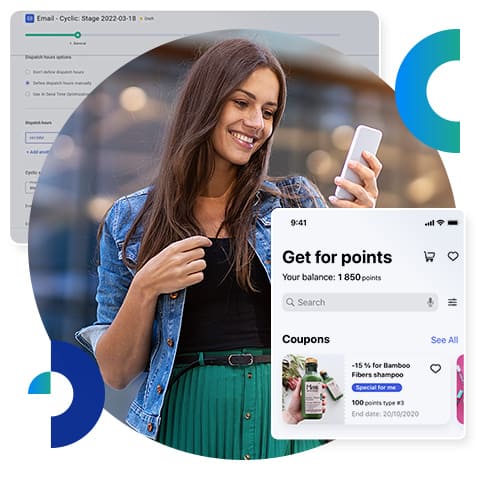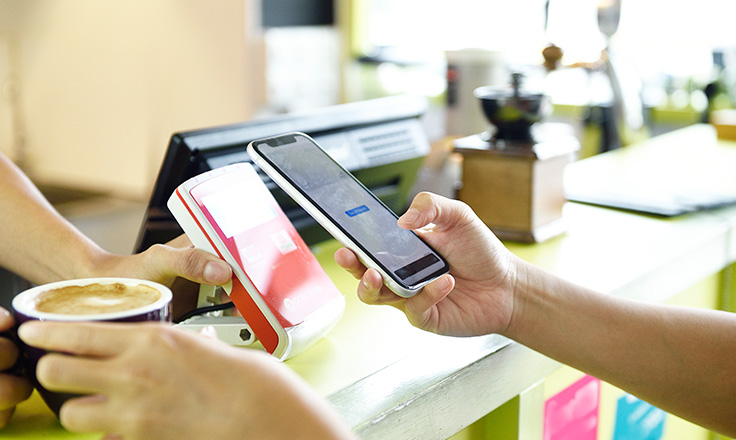A Simple Guide to Loyalty Programs in Retail
- Published
- 8 min reading

It is not uncommon for those who are new to the world of loyalty marketing to think that all loyalty programs work the same way or have equal benefits. Some may even be tempted to say that “visuals aside, if there are any technical differences, they are very, VERY small”. But as it often is in life, the smallest of details can make a huge difference – for example, they can change the way customers experience and perceive your brand.
If you’re working in retail and your intention is to drive growth, you have to make sure that your new loyalty program is designed with your industry in mind. We are here to help you with that and tell you what a retail loyalty program is exactly, what it should look like, how to develop it, and what mistakes you should avoid while creating it.
What is a Retail Loyalty Program?
A retail loyalty program, very much like a regular loyalty program, is a scheme that recognizes and rewards customers for engaging with your brand on a recurring basis, however, it is built with retail-specific conditions, challenges, and requirements in mind.
Retail loyalty programs are often transaction-focused, meaning they are created to help facilitate the buying process (for example by providing the “buy now” option, offering free shipping or extended return periods, etc.). Pairing your store with a retail loyalty program can result in higher purchase frequency and a larger basket value – the two things that every retailer wants.
Considering that online shopping is projected to grow to 27% of overall retail sales by 2023, as a retailer, you should explore new virtual ways of getting customers to buy your products or services. The industry has already responded to this – according to Gartner, 71% of retail brands are using membership programs to drive business performance.
Not only does this show how important customer loyalty in retail is, but it also indicates that it would be a shame not to jump on the bandwagon and use a retail loyalty program yourself to build stronger customer relationships.
5 Types of Loyalty Programs for Retailers
1. Rewards Points Programs
This is the simplest and most common type of loyalty program and it can work wonders for retailers. The basic idea is this – the more a customer spends, the bigger the reward.
It means that every time a customer interacts with your brand (for example, they buy something from you, either in-store or online), they receive a specific amount of loyalty points for performing that action. Customers are encouraged to collect points until they have enough to be able to redeem them for a reward (for example, a discount, free gift, special offer, etc.).
This type of retail loyalty program works best for businesses in which overall purchase frequency is high; in an environment where customers can collect a lot of loyalty points over a short period of time.

2. Tiered Loyalty Programs
You could say that this type feels like an extension or a variant of the rewards points programs, as it involves creating a system where you present your customers with different benefits, offers, or discounts depending on their spending level.
Your customers’ spending determines their rank – or tier. In other words, depending on how much customers interact with your brand, they are placed within a specific group that receives a dedicated set of rewards, services, or benefits. To move up in the hierarchy, that is to become part of the “next-level” group that receives more valuable incentives, your customers must become more engaged in your brand (buy more of your products more often).
Long story short, a tiered loyalty program is about providing your customers with new perks and benefits once they reach a specific level of spending.
3. Partner Programs
Customers like it when they are presented with more exciting opportunities. Thus, another valid option is to create a loyalty program that your partners will be able to join so that you can work together on rewarding your mutual customers and encouraging them to buy more from both sides.
A partner retail loyalty program is also your chance to introduce your brand to a new group of customers who have already put their trust in your business partner. To put it differently, it is as if your partner had recommended your brand to its own clients. Considering that 92% of consumers trust recommendations from friends, you can only gain benefits from it, provided that the relationship between your partner and its customers is a friendly one.
A partner retail loyalty program will be most applicable in the case of companies whose products are often purchased together, like coffee and donuts, or chips and soda. It will also work in a situation where brick-and-mortar stores of two or more brands are located nearby one another.
4. Referral Programs
Speaking of making referrals, this kind of retail loyalty program will help you generate a bigger buzz around your brand as it allows members to promote your products or services among their friends and family, and then receive an incentive for doing so.
As we already mentioned, customers trust their friends, therefore, using a referral reward program is a great way to grow your customer base organically.
Also, receiving a reward – especially in the form of money – is always a great motivator. Knowing that people tend to give more negative reviews than positive ones, you can give your customers a great reason to speak of your brand in superlatives. Don’t miss out on that opportunity.
5. Paid Loyalty Programs
Sometimes called “pay-to-play loyalty programs”, these are programs in which customers pay a monthly or annual fee to join them. Therefore, they feel more like a VIP member of an exclusive club than a loyalty program per se.
These types of programs are pretty common (just look at Amazon Prime) and they can bring a lot of profits, especially when being part of your VIP club means you get access to exclusive benefits and rewards that are not available to non-members.
Remember, customers will pay an upfront fee only when they receive added value – so before you create a paid loyalty program, you must make sure that you will be able to provide its members with what they will find truly valuable.
Key Features & Elements of Modern Loyalty Programs for Retailers
Loyalty App
First things firsts, the best loyalty programs are those that come with a great loyalty program app. The application is your way to connect with your customers and think outside the brick-and-mortar-store box.
By getting your customers to install your app on their mobile devices, you create a situation where your brand is literately at their fingertips – which increases the likelihood of them interacting with you in the future.
However, for your customers to be interested in adding your application to their collection of apps, it must not only be visually appealing and user-friendly. Your app should reflect your company’s values and be designed with your industry – and the type of your customer loyalty program – in mind.
Retail Personalization
You cannot create a long-term relationship with someone about whom you know close to nothing. This means two things.
The first one is that you need to find out who your customers are – what they like, which products they are interested in most, over which communication channels they want to be approached etc. (this can be done, for example, by analyzing zero and first-party data).
The second one is that almost every piece of content that you present your customers with via your retail loyalty program should be personalized. Using what you know about your customers, you can divide customers into segments (groups that share similar interests and preferences) and design dedicated customer journeys that will correspond with the requirements of those that are part of a given segment.
What we’re trying to say here is that, based on past customer interactions, you can create the right message for the right customer and then send it to them over the right communication channel at the right time. In the world of loyalty, that is key.
POS Integration
Pairing your POS system with your customer loyalty program has two big benefits.
Firstly, it increases the possibility that your brick-and-mortar employees will register new customers to your retail loyalty program.
And secondly, it allows you to better track your loyalty program members’ shopping behaviors and spending habits. Every registered transaction will be used to build an extensive consumer profile of a given customer so that you can find out which offers and rewards would really hit their spot. This will enhance personalization across your marketing channels and bring you new ideas for how to retain customers.

How Not to Lose Money When Running a Retail Loyalty Program
To be able to create the type of loyalty program that you want and use all of the features/elements we covered in this article, you need the right tools.
There are many IT solutions available on the market that, on paper, are said to be powerful enough to help realize your loyalty marketing vision. Unfortunately, though advertised as such, not all of them are. So, if you don’t want to lose money when running a retail loyalty program, you need to start by choosing the right loyalty software provider.
For example, with the help of our Loyalty Marketing Platform, not only can you design, run, and manage a omnichannel loyalty program that your customers will love, but you can also monitor its performance, as well as identify your customers’ shopping trends thanks to advanced AI/Machine-Learning algorithms.
A solution like ours will allow you to create an original loyalty program that will stand out, not just copy what your competitors are doing. Customers want to be surprised, therefore, you don’t want technology to limit your imagination. That, indeed, would be a waste of time, energy, and money. You need a set of loyalty marketing tools that will be your brush and canvas, while you will be the painter. So, choose wisely.
Why Invest in a Retail Loyalty Program Software
Knowing that almost three-quarters of retail brands use membership programs, it doesn’t take much to put two and two together and realize that not only do such investments pay off, but they are also essential in the retail environment.
Today’s marketing is no longer about building a customer base – it is about building a community and making sure that those that are part of it will stay for as long as possible.
Retail loyalty programs are a means of building communities, which also translates into them being one of the reasons why customers reside in one brand’s camp for an extended period of time. They are also proven means of increasing Customer Lifetime Value (CLV) and customer retention which explains why they are so profitable.
As revealed by HubSpot, a 5% increase in customer retention can result in a 25 to 95% boost in profitability – we don’t need to elaborate on that, do we?
So, what you need is a good idea for a loyalty program and the right IT tools with the use of which you will make it happen. Fortunately for you, some loyalty marketing platform providers, such as Comarch, can help you with the first part as well.
Use the loyalty marketing platform to create the type of loyalty program that will reflect your company’s values best. That way you will increase your chances of your program becoming successful.
If you want to know more about how you can do that – and how to take your retail customer experience to the next level – you can check out our website and we’ll show you how to turn your customers into shopaholics.





